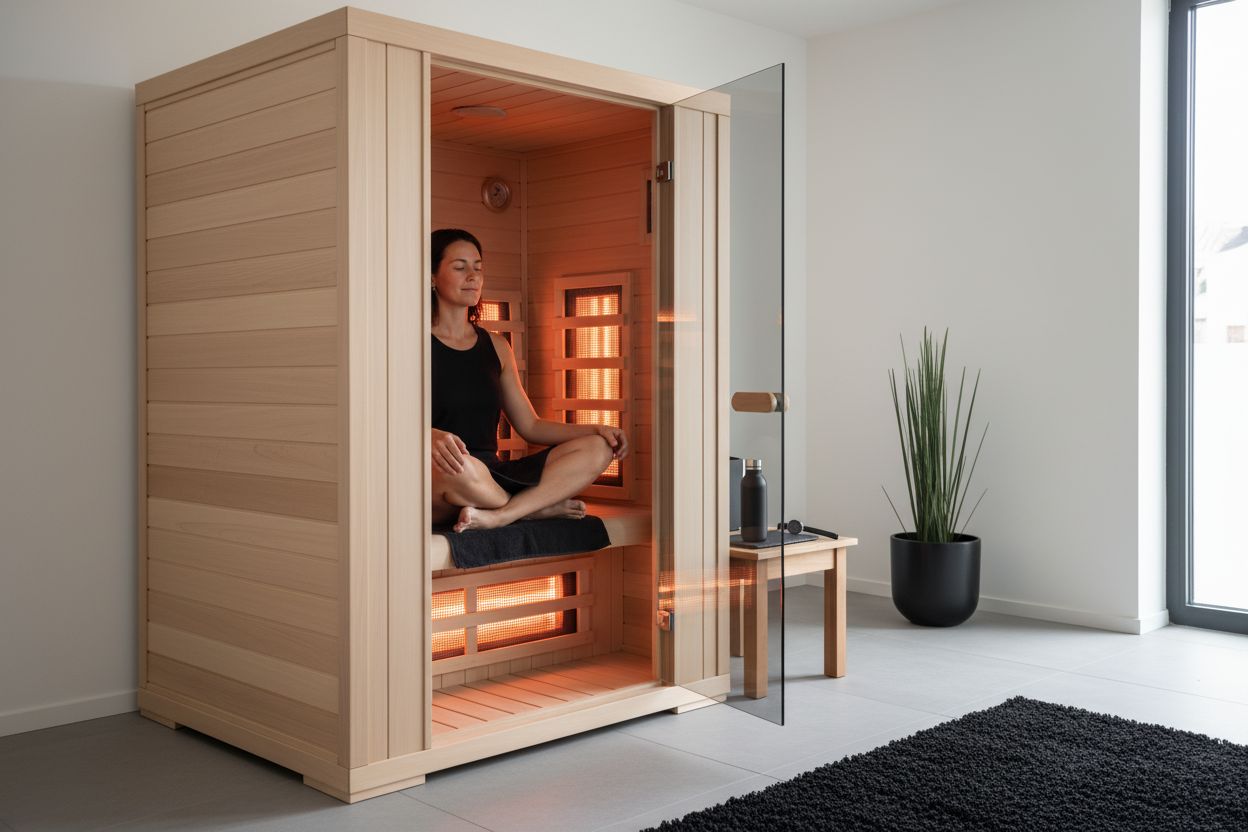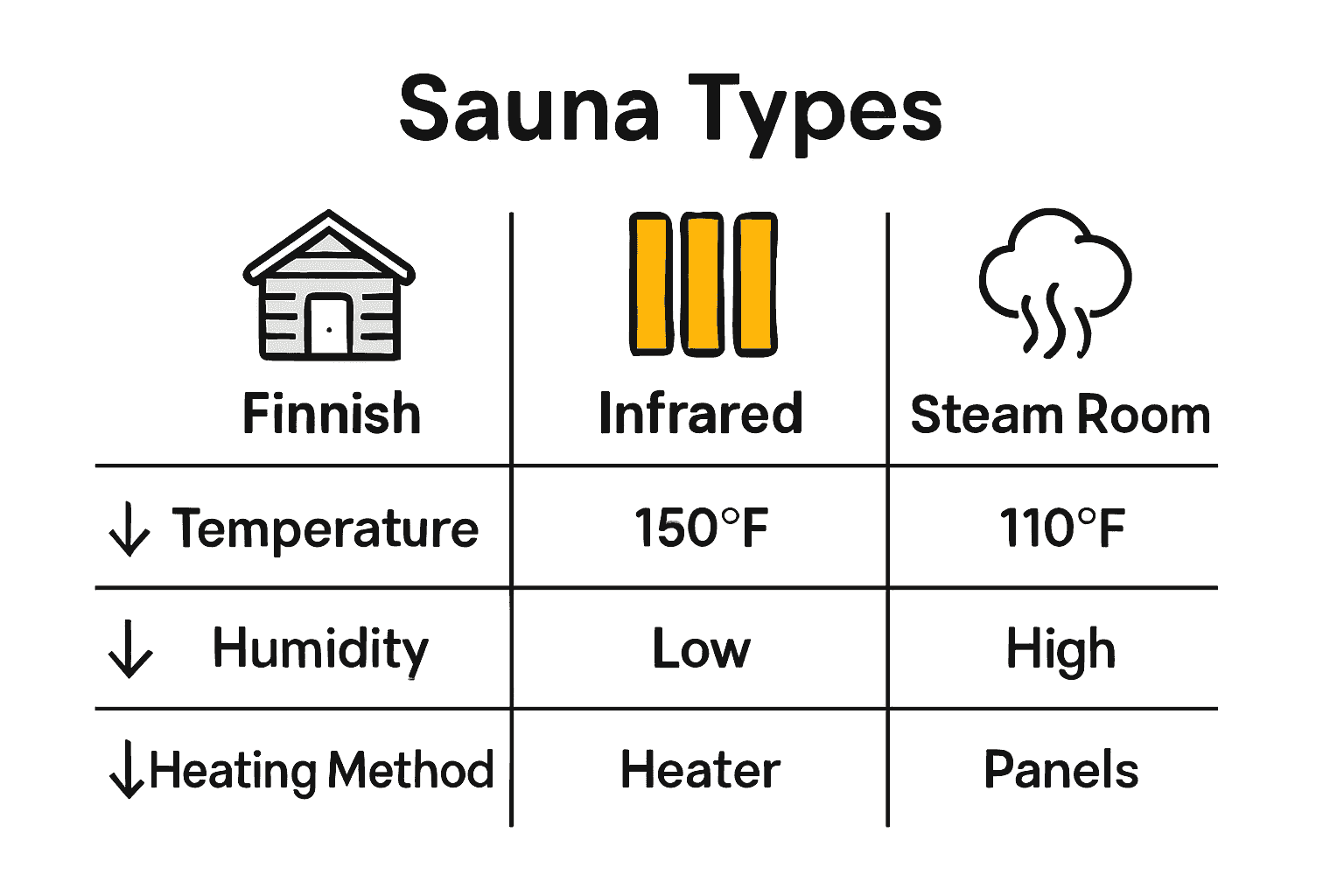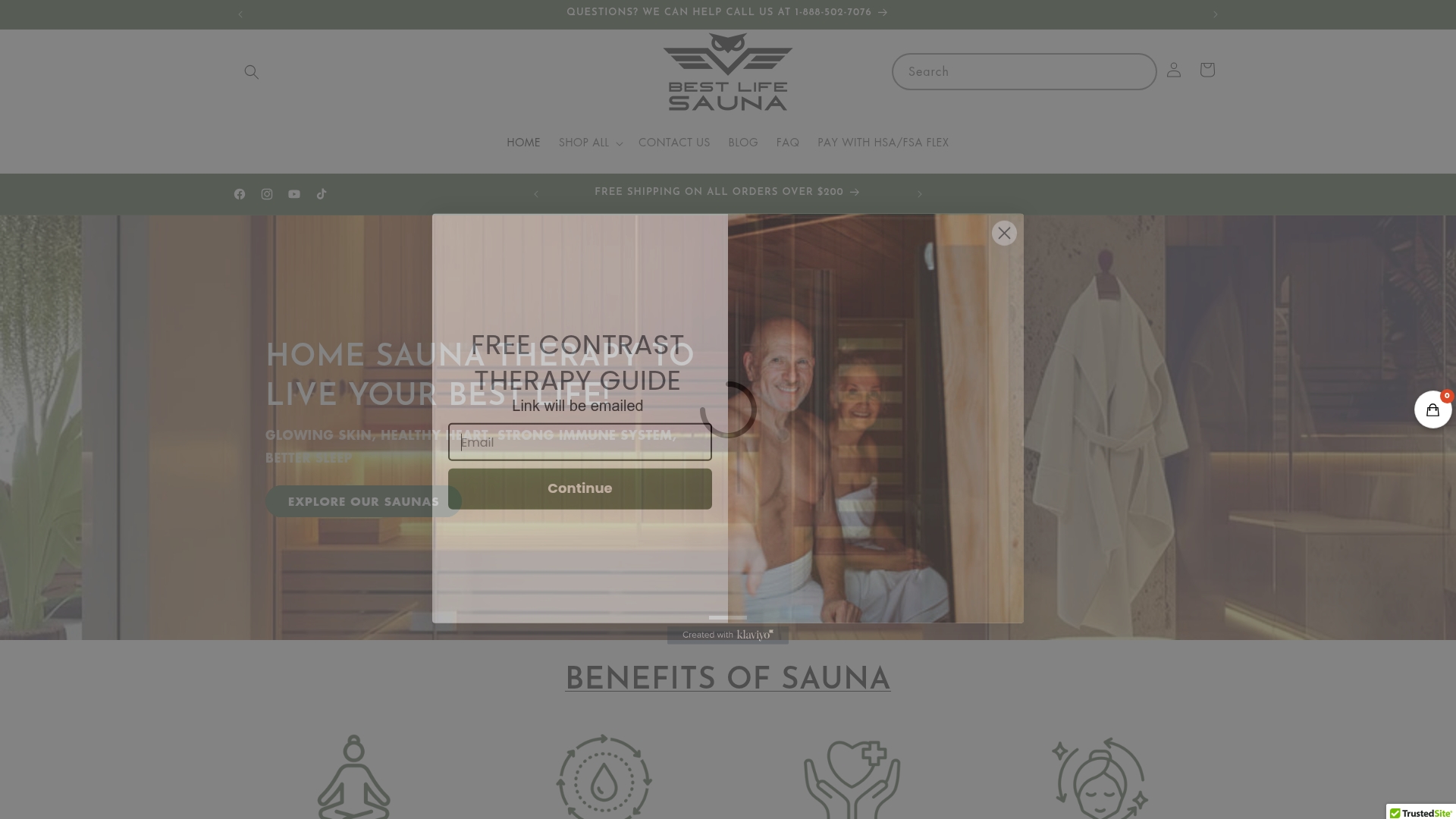
What to Expect in Sauna: Complete Guide to Sauna Use
Did you know that regular sauna use is linked to a 65 percent lower risk of sudden cardiac death? Saunas deliver much more than relaxation, giving your body a workout at a cellular level. As people seek effective ways to support heart and overall health, understanding the reality behind sauna experiences and common myths becomes vital. This article helps you uncover the real science and practical insights to make the most of every sauna session.
Key Takeaways
| Point | Details |
|---|---|
| Sauna Types | Understanding various sauna types, including Finnish, infrared, and steam rooms, helps tailor the sauna experience to personal health goals. |
| Health Benefits | Regular sauna use is linked to significant health improvements, particularly in cardiovascular health and mental wellness. |
| Preparation & Etiquette | Proper hygiene, minimal clothing, and respectful behavior enhance the sauna experience and ensure comfort for all users. |
| Safety Precautions | Be aware of medical conditions that may contraindicate sauna use and follow safety guidelines to prevent risks. |
Table of Contents
- Defining Sauna Experiences And Common Myths
- Exploring Major Sauna Types And Variations
- Health Benefits And Wellness Expectations
- Proper Sauna Etiquette And Preparation Steps
- Safety Guidelines, Risks, And Contraindications
Defining Sauna Experiences and Common Myths
Saunas represent more than just a hot room - they’re a centuries-old wellness practice with profound physiological benefits. Sauna bathing is an immersive experience that goes far beyond simple sweating, engaging complex bodily responses that can positively impact overall health. According to research from Wikipedia, sauna bathing creates mild heat stress that activates heat shock proteins associated with longevity and protection against chronic illness.
Types of Sauna Experiences
Traditionally, saunas come in multiple variations, each offering unique characteristics:
- Traditional Finnish Saunas: High heat, low humidity environments typically ranging 170-210°F
- Infrared Saunas: Lower ambient temperatures that use radiant light to penetrate body tissues
- Steam Rooms: High humidity environments focused on moisture and respiratory benefits
Common Sauna Myths Debunked
Misconceptions about saunas are widespread, but scientific research provides clarity. According to Wikipedia, while infrared saunas demonstrate potential benefits like blood pressure normalization and chronic pain relief, many health claims remain scientifically unsubstantiated. Critically, regular sauna use has been linked with remarkable health outcomes, including:
- Reduced risk of sudden cardiac death
- Lower blood pressure
- Improved arterial function
- Enhanced heat shock protein activation
Understanding sauna experiences means recognizing them as more than just a trendy wellness activity - they’re a scientifically-backed practice with potential long-term health implications. Whether you’re seeking relaxation, potential health benefits, or simply enjoying a therapeutic heat experience, saunas offer something unique for everyone.
Exploring Major Sauna Types and Variations
Sauna types represent diverse approaches to heat therapy, each offering unique experiences and potential wellness benefits. Understanding these variations helps you select the perfect sauna environment tailored to your health goals and personal preferences. From traditional wood-fired chambers to modern technological innovations, the world of saunas is rich with fascinating options.
Traditional Finnish Saunas
Classic Finnish saunas remain the gold standard in heat therapy, characterized by high temperatures and low humidity. These authentic experiences typically involve:
- Wood-burning or electric heating elements
- Temperatures ranging between 150-220°F
- Occasional water splashing on hot stones to create brief steam bursts
- Wooden interior construction using cedar, spruce, or hemlock
Infrared Sauna Variations
Infrared saunas represent a modern technological approach to heat therapy. Unlike traditional saunas, these utilize electromagnetic waves that directly penetrate body tissues:
- Lower ambient temperatures (110-140°F)
- Deeper tissue heating without extreme environmental heat
- Available in multiple spectrum variations:
- Near-infrared
- Mid-infrared
- Far-infrared technologies
Emerging Sauna Innovations
Contemporary sauna designs continue expanding beyond traditional models, introducing specialized experiences like:
- Outdoor barrel saunas
- Portable infrared units
- Urban spa-style commercial installations
- Hybrid models combining multiple heating technologies
Whether you’re seeking intense heat immersion, gentle therapeutic warmth, or cutting-edge wellness experiences, the diverse world of saunas offers something for every preference and health objective. Your ideal sauna journey begins with understanding these fascinating variations.

Here’s a comparison of major sauna types and their key features:

| Sauna Type | Temperature Range | Humidity Level | Heating Method |
|---|---|---|---|
| Finnish (Traditional) | 150-220°F | Low | Wood/Electric heater |
| Infrared | 110-140°F | Very low | Infrared panels |
| Steam Room | 110-120°F | High (Steamy) | Steam generator |
| Outdoor Barrel | 150-210°F | Low-Moderate | Wood/Electric heater |
| Hybrid | 110-210°F | Adjustable | Combo: Infrared & Stones |
Health Benefits and Wellness Expectations
Sauna therapy represents far more than a relaxing experience - it’s a powerful wellness intervention with scientifically documented health advantages. According to research from Wikipedia, frequent sauna use correlates with significant physiological improvements, particularly in cardiovascular health. The body’s response to controlled heat exposure triggers a cascade of positive biological mechanisms that can enhance overall wellness.
Cardiovascular and Physiological Benefits
The potential cardiovascular advantages of regular sauna sessions are remarkable. Research indicates that consistent sauna bathing is associated with:
- Decreased risk of sudden cardiac death
- Reduced blood pressure
- Improved arterial function
- Decreased arterial stiffness
- Activation of protective heat-shock proteins
Cellular and Metabolic Responses
Beyond cardiovascular improvements, sauna use stimulates complex cellular responses that promote long-term health. The controlled heat stress induces:
- Enhanced metabolic efficiency
- Improved thermal regulation
- Potential longevity-promoting cellular adaptations
- Potential reduction in systemic inflammation
Mental Health and Recovery Expectations
Sauna experiences extend beyond physical benefits, offering significant mental wellness advantages:
- Stress reduction through relaxation
- Improved sleep quality
- Enhanced mood regulation
- Potential reduction in anxiety symptoms
- Natural endorphin release
Understanding sauna therapy means recognizing it as a holistic wellness practice. While individual experiences vary, the potential for comprehensive health improvement makes saunas a compelling addition to proactive wellness strategies. Your personal journey will depend on consistency, technique, and individual physiological responses.
Proper Sauna Etiquette and Preparation Steps
Sauna preparation is an art form that balances personal comfort, cultural norms, and health considerations. According to Wikipedia, different cultures have unique approaches to sauna use, with Finnish traditions offering some of the most established guidelines. Understanding these nuanced practices ensures a respectful, comfortable, and beneficial sauna experience.
Pre-Sauna Hygiene and Preparation
Proper preparation is critical for an optimal sauna session. Essential steps include:
- Take a thorough shower before entering
- Hydrate well before and after sauna use
- Bring a clean, absorbent towel to sit on
- Remove all jewelry and metal accessories
- Wear minimal, loose-fitting clothing or use appropriate coverings
Sauna Seating and Positioning
Navigating sauna spaces requires understanding temperature variations and cultural norms. Key considerations:
- Higher benches are significantly hotter
- Always sit on a clean towel for hygiene
- Move between bench levels to regulate heat exposure
- In many cultures, especially Finnish settings, nudity is culturally acceptable in private and appropriate public saunas
Cultural and Practical Etiquette
Sauna experiences demand respect for shared spaces and fellow users:
- Maintain quiet, calm demeanor
- Avoid strong perfumes or body odors
- Respect personal space
- Use minimal water on hot stones
- Clean up after yourself
- Be mindful of others’ comfort levels
Your sauna journey is a personal wellness experience. By understanding and respecting these guidelines, you’ll create a more enjoyable, comfortable, and culturally sensitive environment for yourself and other sauna enthusiasts.
Safety Guidelines, Risks, and Contraindications
Sauna safety requires careful consideration of individual health conditions and personal physiological responses. While saunas offer numerous wellness benefits, understanding potential risks and implementing appropriate precautions is crucial for a safe and enjoyable experience. Responsible sauna use means being aware of your body’s limitations and taking proactive measures to protect your health.
Medical Conditions and Contraindications
Certain health circumstances may require additional caution or complete avoidance of sauna therapy:
- Individuals with uncontrolled hypertension
- People experiencing acute illness or fever
- Those with cardiovascular disorders
- Pregnant women (consult healthcare provider)
- Individuals with severe skin conditions
- Persons taking medications affecting heat regulation
Critical Safety Precautions
Important safety guidelines to minimize potential risks:
- Limit initial sessions to 10-15 minutes
- Stay hydrated before, during, and after sauna use
- Exit immediately if feeling dizzy, nauseous, or uncomfortable
- Avoid alcohol consumption before or during sauna sessions
- Use the buddy system for first-time or extended sessions
Risk Mitigation Strategies
Additional recommendations for safe sauna experiences:
- Start with lower temperatures and shorter durations
- Listen to your body and respect its signals
- Keep a water bottle nearby for hydration
- Use a clean towel to sit on
- Avoid sudden temperature changes
- Cool down gradually after sauna use
Your personal health and safety should always be the primary consideration. When in doubt, consult with a healthcare professional to determine whether sauna therapy is appropriate for your individual health profile. Remember, responsible enjoyment is the key to a positive sauna experience.
Ready to Transform Your Wellness Journey at Home?
You have learned what to expect in a sauna and how different types, preparation steps, and safety guidelines shape the experience. Are you eager to enjoy the stress relief, health boosts, and deep relaxation described in this complete guide, but unsure which sauna fits your goals and space? Many readers struggle to find reliable, high-quality sauna solutions that deliver lasting wellness benefits. At Best Life Sauna, you will discover expertly curated sauna products and accessories that reflect the best of what you have just read. From traditional Finnish setups to advanced infrared sauna options, we make it simple to create your own personal retreat. Experience the same health advantages explored in the article with premium products backed by outstanding customer support, free shipping on orders over $200, and our price match promise.

Take your first step toward better well-being today. Visit Best Life Sauna’s website for exclusive offers and shop our wide range of saunas, cold plunge tubs, and wellness essentials. The benefits you want are closer than ever when you choose the right solution now.
Frequently Asked Questions
What are the different types of saunas available?
Saunas come in various types, including Traditional Finnish Saunas, Infrared Saunas, and Steam Rooms. Each type offers unique heat experiences, ranging from high heat and low humidity to lower temperatures with higher moisture.
What health benefits can I expect from sauna use?
Regular sauna use can lead to numerous health benefits, including reduced risk of sudden cardiac death, lower blood pressure, improved arterial function, and enhanced mental well-being through stress reduction and better sleep quality.
How should I prepare for a sauna session?
Preparation for a sauna session involves showering beforehand, hydrating well, bringing a clean towel to sit on, and wearing minimal clothing. It’s essential to remove jewelry to avoid discomfort in the heat.
What are the safety guidelines for using a sauna?
Safety guidelines include limiting initial sessions to 10-15 minutes, staying hydrated before and after use, listening to your body, and exiting if you feel dizzy or uncomfortable. Individuals with certain medical conditions should consult a healthcare provider before use.

